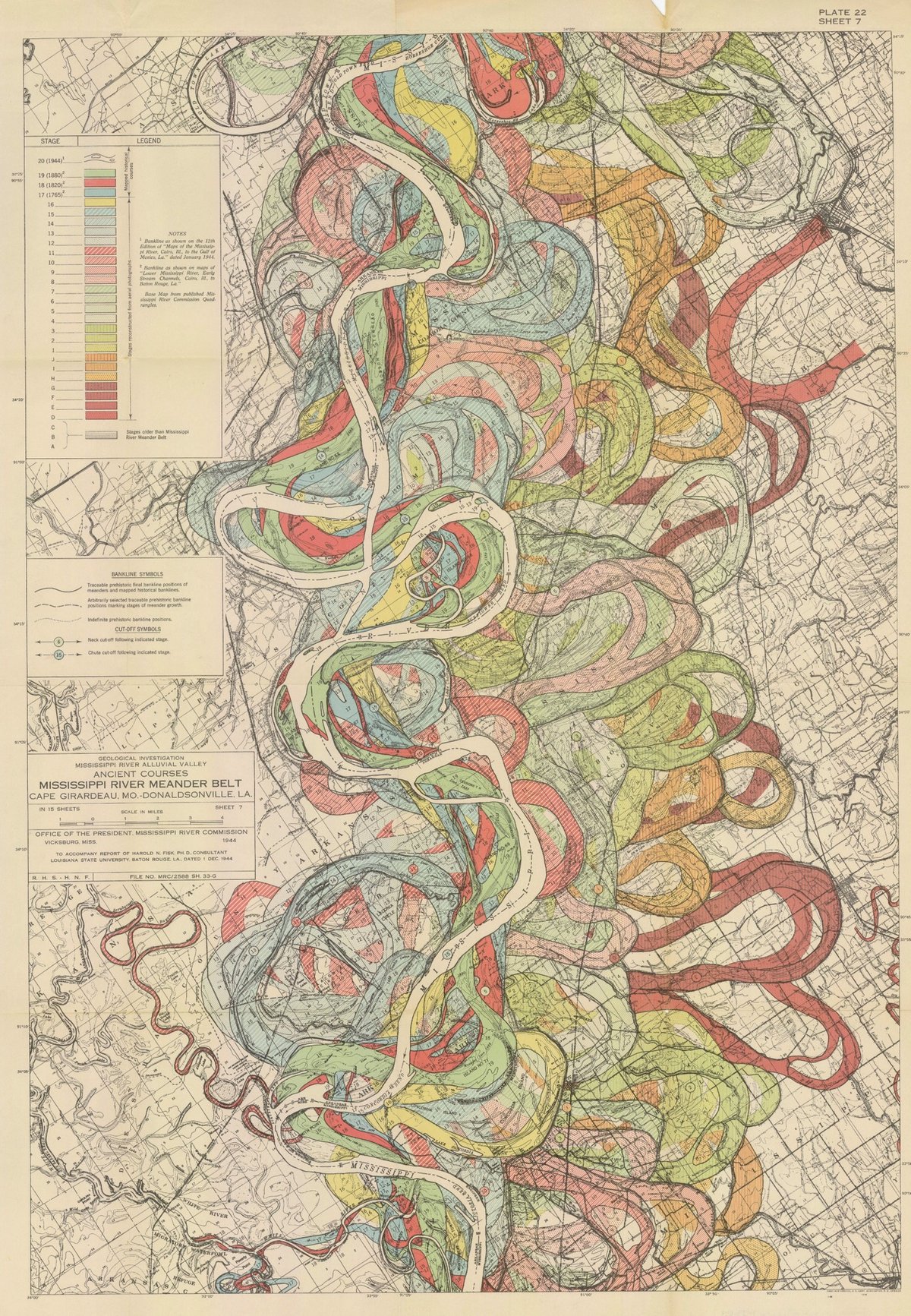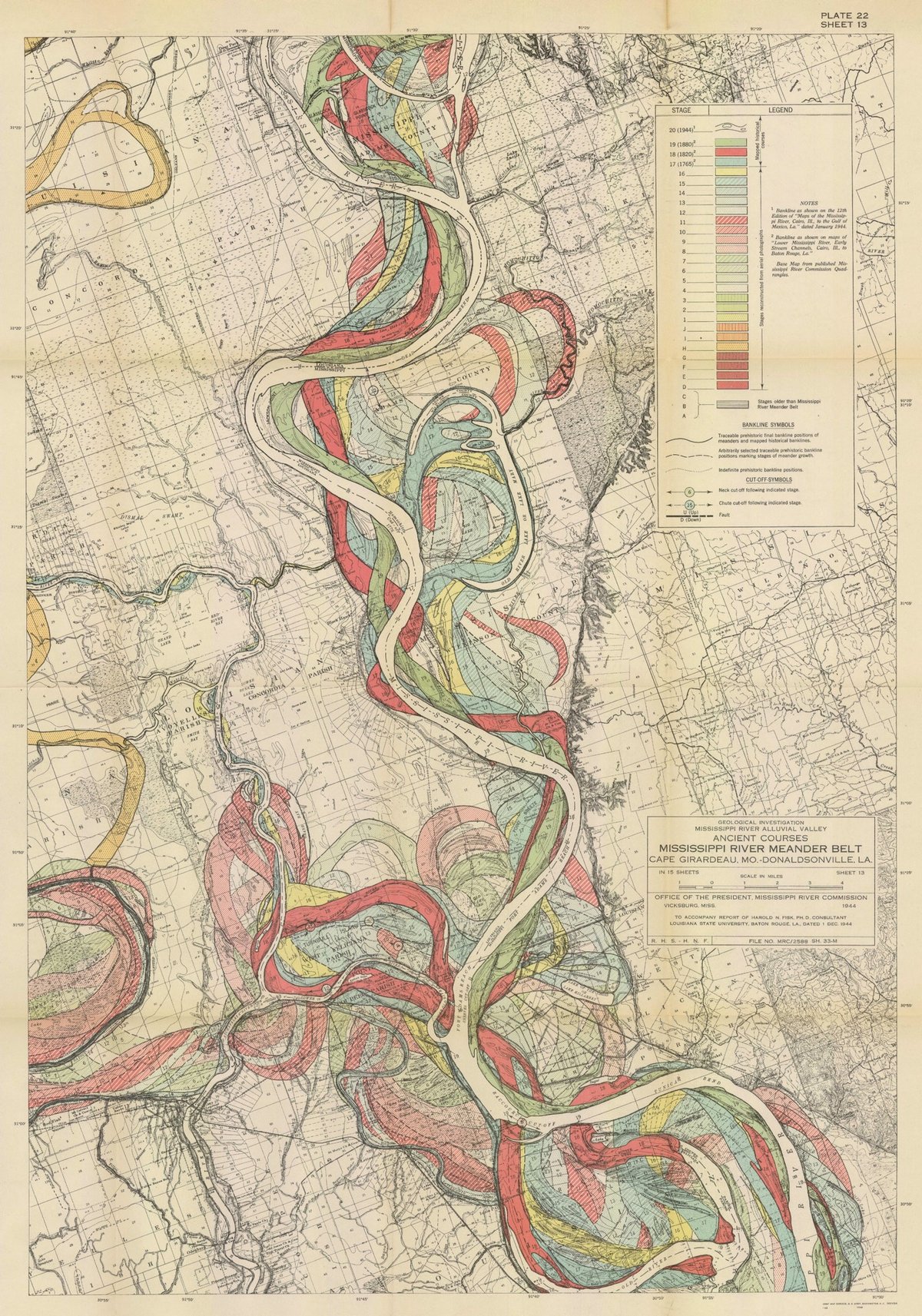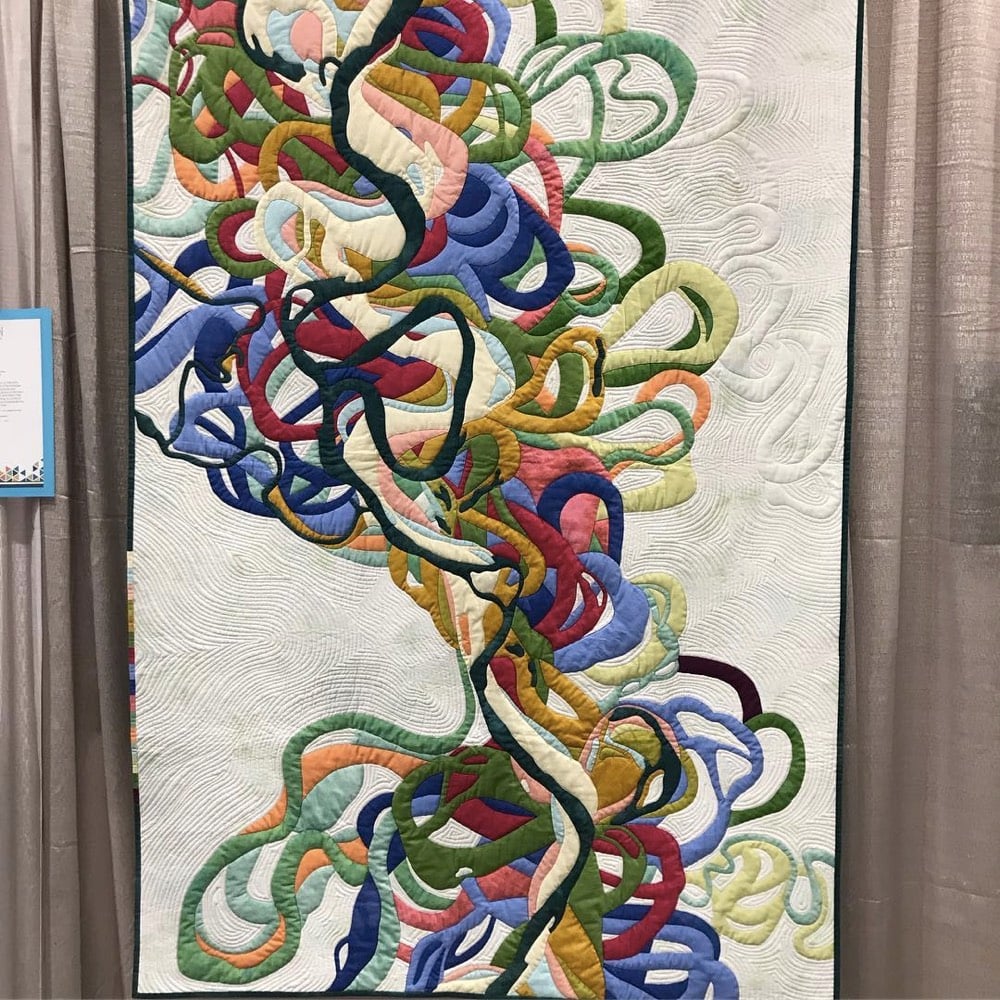

I have long admired the Mississippi River meander maps designed by Army Corps of Engineers cartographer Harold Fisk but have somehow never written a whole post about them. So when my pals at 20x200 reached out wanting me to write a blog post for them about their Fisk prints, I jumped at the chance. It gave me an excuse to write about art as time travel and, in particular, how Fisk’s clever map compresses thousands of years of a river’s activity into a single image.
It takes some imagination, but standing before a painting by Hilma af Klint, a sculpture by Bernini, or a cave painting in Chauvet, France draws you back in time in a powerful way: you know you’re standing precisely where those artists stood hundreds or even thousands of years ago, laying paint to surface or chisel to stone. Even experiencing art through prints or photographs leads the mind to consider all the cultural, political, technological, and economic things that were happening when the work was produced. Art is a doorway to past worlds.
Fisk’s maps represent the memory of a mighty river, with thousands of years of course changes compressed into a single image by a clever mapmaker with an artistic eye. Looking at them, you’re invited to imagine the Mississippi as it was during the European exploration of the Americas in the 1500s, during the Cahokia civilization in the 1200s (when this city’s population matched London’s), when the first humans came upon the river more than 12,000 years ago, and even back to before humans, when mammoths, camels, dire wolves, and giant beavers roamed the land and gazed upon the river.
You can buy prints of Fisk’s maps at 20x200…they have several available at all kinds of different sizes, framed and unframed.
Update: With LIDAR, the past meanderings of rivers can be seen more clearly (and no less artistically) than in Fisk’s maps. Here’s a LIDAR image of the Mississippi River along the border of Arkansas and Mississippi:

And don’t miss Daniel Coe’s morphing GIF of Fisk’s map to the LIDAR image. (via @macgbrown)
Update: Ahhh, look at this meander quilt from Timna Tarr:

And check out some of the other quilts in her gallery…very cool. (thx, rachel)
Update: Cathy Fussell has also created quilts based on Fisk’s maps.
I don’t know if this needs a disclaimer or not, but 20x200 paid me a modest amount to write this blog post for their site but not the post you’re reading now. 20x200 didn’t pay me to write this here post; they didn’t even ask me if I would link to their post from my site. I once wrote a slightly longer (and progressively unhinged) disclaimer for a previous post about 20x200.
Congrats to Jen Bekman on getting funding for 20x2001.
“I love the idea of taking the friction out of the art world,” said Mr. Conrad. “A lot of people want to buy nice things, but don’t know how. Jen has built a business from that, which is growing very nicely and has a lot of repeat customers.”
[1] In light of the new FTC guidelines for disclosure by bloggers2, a few somewhat relevent statements. 1. 20x200 has in the past paid $1200 to sponsor the kottke.org RSS feed. 2. I have linked to 20x200 and Jen Bekman’s gallery several times on kottke.org, for which Jen Bekman has thanked me, which is a good feeling, to be thanked, and perhaps that subconsciously predisposes me towards future linking because who doesn’t like to be thanked? 3. Jen Bekman is a friend. 4. I also know Caterina Fake, Zach Klein, and Scott Heiferman socially; they are a few of 20x200’s angel investors. 5. I am a resident of New York City, in which 20x200 is headquartered. 6. I have purchased art from 20x200 in the past. 7. I may have received a 20x200 print from Jen Bekman herself, either as a straight-up gift or as a promotional item. Honestly, I can’t remember if she gave me anything, what it was, or the circumstances of the giving. 8. I have received 20x200 prints as gifts from others. They are thanked. 9. I know my wife and my wife knows Jen Bekman. 10. I may have unwittingly posed for photos next to 20x200 artwork hanging in my residence or in the residences of others, giving the impression that I am endorsing said artwork. Apologies. 11. I have agreed to, at some point in the future, curating a selection of artworks for 20x200 and then chatting casually with Jen Bekman about my choices, an edited transcript of which will appear on the 20x200 web site. As far as I know, no payment for this service is forthcoming and if it was, I would refuse it politely. 12. Jen Bekman’s dog’s name is Ollie. So is my son’s. ↩
[2] Why just for bloggers? Do New York Times book, music, and movie reviewers disclose that they received review copies for free? ↩
Jason Polan, who you may remember from the series of drawings he did of every piece of art in the MoMA, has a unique 20x200 offering available. The larger editions are drawings and copies of his hand while the $2000 edition of 2 is described thusly:
I will come to your house and shake your hand. Two of these interactions will be available. After I meet you I will give you a certificate, to be signed by both you and me, stating the authentification of the encounter. This artwork is a collaboration between you and me. You will also receive a photograph that is taken the moment of our meeting.
20x200 curator Jen Bekman has more on this offering.
Jason’s work is about a lot of lofty ideas, but those ideas are grounded in the most mundane of media and happenstance. The ideas center around his ambitions to interact authentically with both the media he chooses to work in and the collectors who buy his work.









Stay Connected